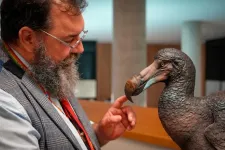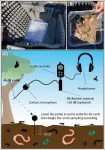(Press-News.org) With new medications on the market or in the works for Alzheimer’s disease and other kinds of dementia, a new study suggests that getting the diagnosis needed to access these new treatments may depend on where you live.
The percentage of people who get a new dementia diagnosis each year varies a lot across regions of the U.S., the study finds.
And the differences between regions of the country are even larger for people on the young end of the dementia-risk age range, ages 66 to 74, and for those who are Black or Hispanic.
In fact, the same person would have as much as twice the chance of getting a dementia diagnosis in some areas of the U.S. as in others, the study shows. The findings suggest that the chance of being diagnosed may be more about the health system than about individual factors that affect dementia risk.
A formal diagnosis is required for access to advanced new tests and treatments for dementia. Many of them aim to slow down the progression of dementia in its earliest stages, called mild cognitive impairment or mild Alzheimer’s disease.
The new study focuses on regional differences in “diagnostic intensity” of dementia – the kind of difference that exists even after all kinds of dementia risk factors and regional differences in population and health care are taken into account.
Performed by a team based at the University of Michigan, it’s published in Alzheimer's & Dementia: The Journal of the Alzheimer's Association.
“These findings go beyond demographic and population-level differences in risk, and indicate that there are health system-level differences that could be targeted and remediated,” said Julie Bynum, M.D., M.P.H., the U-M Health geriatrician and health care researcher who led the study.
“The message is clear: from place to place the likelihood of getting your dementia diagnosed varies, and that may happen because of everything from practice norms for health care providers to individual patients’ knowledge and care-seeking behavior,” said Bynum, a professor of internal medicine at the U-M Medical School. “But the good news is, these are things we can act on once we know where to look.”
Bynum and her colleagues at U-M and the Dartmouth College Geisel School of Medicine did the study using data from the records of 4.8 million people who were covered by traditional Medicare and over the age of 66 in 2019.
They note that while nearly 7 million Americans currently have a diagnosis of dementia, millions more likely have symptoms but no formal diagnosis.
Insurance coverage for new biomarker tests, brain imaging scans and dementia-slowing medications depends on diagnosis. But even for those who don’t qualify for these, a confirmed diagnosis can be important for accessing specialized care and support for patients and their family members or friends who act as caregivers.
Going beyond risk factors: More about the study
Researchers have already found many factors that are linked to an individual’s higher risk of developing Alzheimer’s disease and other forms of dementia. These include years of high blood pressure, high cholesterol and tobacco or alcohol use, to lower levels of formal education, sleep and social interaction.
But the new study shows for the first time that the differences in diagnosis by region aren’t explained by differences in the dementia risk level of different populations.
It looked at diagnoses within each of 306 hospital referral regions developed for the Dartmouth Atlas of Health Care and used in many studies. Each HRR includes at least one hospital capable of doing advanced heart surgery and brain surgery; the researchers chose to use these regions because dementia diagnosis and advanced treatment also requires specialized services.
In all, 143,029 of the people in the total population used in the study were newly diagnosed with Alzheimer’s or another form of dementia in 2019. The rest of the 356,656 people who had that diagnosis in this population had been diagnosed before 2019.
That means that overall, about 7% of people covered by traditional Medicare have a dementia diagnosis at any given time, and 3% of this population is diagnosed each year, with an average age at diagnosis of about 83 years.
The researchers then calculated the regional rates of new diagnoses and total diagnosed individuals as of 2019 for each HRR. The prevalence of diagnosed dementia ranged from as low as 4% to as high as 14% depending on HRR, and the rate of new dementia diagnoses in 2019 ranged from 1.7% to 5.4%.
They then looked at rates for three age groups – 66 to 74, 75 to 84 and 85 and over – and for people identified as white, Black or Hispanic. They also included data about the percentage of the population in each HRR that had less than a high school education, that smoked, and that had obesity or diabetes – all risk factors for dementia.
They also incorporated information about the general intensity of all kinds of chronic disease diagnosis in each HRR.
By taking all these factors into account, the researchers were able to calculate a predicted rate of diagnosis for new and total Alzheimer’s and dementia cases for each HRR, and for individuals in each HRR. This is what they called diagnostic intensity.
Compared to the national average, people residing areas of the lowest-intensity are 28% less likely to be diagnosed, whereas those residing in areas of the highest-intensity are 36% more likely to be diagnosed.
The general concentration of diagnosed dementia cases was highest in the southern U.S., similar to the “stroke belt” of high risk for stroke and cardiovascular disease.
But the South was no longer a uniform hotbed of dementia diagnosis once the researchers adjusted for the other factors.
Implications for regional change
Bynum explains that the findings could reflect variations in clinical practices – for example, how often people are screened by their primary care physicians for early signs of dementia, or the availability of specialists to make a confirmed diagnosis.
Variation could also stem from cultural or personal differences in how likely a person is to seek care of any kind, to schedule an appointment specifically because of memory concerns, or to mention problems with memory or thinking proactively to a health care provider without being prompted during an existing appointment.
While the researchers can’t say for certain if the variation reflects underdiagnosis or overdiagnosis, they do say that the areas with lower-than-expected diagnosis rates for dementia could use the new findings to look at what barriers might stand in the way of someone getting diagnosed.
“The goal these days should be to identify people with cognitive issues earlier, yet our data show the younger age group of Medicare participants is the one with the most variation,” Bynum said. “For communities and health systems, this should be a call to action for spreading knowledge and increasing efforts to make services available to people. And for individuals, the message is that you may need to advocate for yourself to get what you need, including cognitive checks.”
She adds that Medicare covers a cognitive screening during each enrollee’s annual wellness visit.
She also notes that the recent launch of Medicare’s GUIDE model for dementia care may offer a path to improving care. The model incentivizes clinical practices to coordinate dementia care better and offer around-the-clock access to a trained provider.
In addition to Bynum, the study’s authors are Slim Benloucif and Jonathan Martindale of the U-M Department of Internal Medicine, A. James O’Malley of Dartmouth College and Matthew A. Davis, Ph.D., of the U-M School of Nursing and the U-M Medical School’s Department of Learning Health Sciences.
Bynum and Davis are members of the U-M Institute for Healthcare Policy and Innovation, and leaders of the Center to Accelerate Population Research in Alzheimer’s or CAPRA.
The study was funded by the National Institute on Aging of the National Institutes of Health (P01AG019783).
Full details about the diagnostic intensity rate and other data for each HRR will be available on the CAPRA website and at https://michmed.org/38XeZ .
Citation: Regional variation in diagnostic intensity of dementia among older U.S. adults: An observational study, Alzheimer’s and Dementia, DOI: 10.1002/alz.14092
END
Same person. Different place. Twice the odds of a dementia diagnosis.
National study shows wide variation across the U.S. in likelihood of being diagnosed with Alzheimer’s disease or another form of dementia, even after many factors are taken into account
2024-08-16
ELSE PRESS RELEASES FROM THIS DATE:
The banana apocalypse is near, but UMass Amherst biologists might have found a key to their survival
2024-08-16
August 16, 2024
The Banana Apocalypse is Near, but UMass Amherst Biologists Might Have Found a Key to Their Survival
Discovery of molecular mechanisms used by the banana-destroying microbe brings hope to the breakfast table
AMHERST, Mass. – The bananas in your supermarket and that you eat for breakfast are facing functional extinction due to the disease Fusarium wilt of banana (FWB) caused by a fungal pathogen called Fusarium oxysporum f.sp. cubense (Foc) tropical race 4 (TR4). However, thanks to recent research from an ...
Rethinking the dodo
2024-08-16
Rethinking the Dodo
Review of 400 years of scientific literature corrects the record on icon of extinction
Researchers are setting out to challenge our misconceptions about the Dodo, one of the most well-known but poorly understood species of bird.
In a paper published today [16 August 2024] in the Zoological Journal of the Linnean Society researchers from the University of Southampton, Natural History Museum (NHM) and Oxford University Museum of Natural History have undertaken the most comprehensive review of the taxonomy of the Dodo and its closest relative, the Rodriguez ...
Arts and crafts improves your mental health as much as having a job, scientists find
2024-08-16
Could arts and crafts help protect the public’s mental health? A new study in Frontiers in Public Health provides evidence that indulging our creative side could provide everyone with a significant wellbeing boost. Because arts and crafts are relatively affordable and accessible, promoting the public’s access to artistic activities could provide a major boost to public mental health.
“Crafting and other artistic activities showed a meaningful effect in predicting people’s ...
It’s a rave – underground acoustics amplify soil health
2024-08-16
Barely audible to human ears, healthy soils produce a cacophony of sounds in many forms – a bit like an underground rave concert of bubble pops and clicks.
Special recordings made by Flinders University ecologists in Australia show this chaotic mixture of soundscapes can be a measure of the diversity of tiny living animals in the soil, which create sounds as they move and interact with their environment.
With 75% of the world’s soils degraded, the future of the teeming community of living species that live underground face a dire future without restoration, says microbial ecologist Dr Jake Robinson, from the Frontiers ...
New poll finds 50% of parents believe too much time on technology hinders kids from forming connections in the classroom
2024-08-16
COLUMBUS, Ohio (August 16, 2024) – Building positive connections with teachers and peers in the classroom can be critical to the mental health and academic success of children and adolescents. Yet, a new national poll from The Kids Mental Health Foundation, conducted by Ipsos, finds half of parents believe spending too much time on technology and social media hinder children from making meaningful connections as they head into the upcoming school year.
The poll, conducted by Ipsos on behalf of ...
How policing impacts the homeless
2024-08-16
People who are homeless often endure constant and intrusive police interactions, leaving them feeling intimidated, harassed and stigmatised, a new study finds.
More people of all ages and backgrounds are finding themselves homeless, often due to job loss or illness, as well as a lack of affordable housing. Between 2016 and 2021 homelessness increased by 5.2% in Australia.
Professor of Law Thalia Anthony from the University of Technology Sydney (UTS) said the research aimed to give a voice to people experiencing homelessness ...
Scottish and Irish rocks confirmed as rare record of ‘snowball Earth’
2024-08-16
A rock formation spanning Ireland and Scotland may be the world’s most complete record of “snowball Earth”, a crucial moment in planetary history when the globe was covered in ice, finds a new study led by UCL (University College London) researchers.
The study, published in the Journal of the Geological Society of London, found that the Port Askaig Formation, composed of layers of rock up to 1.1km thick, was likely laid down between 662 to 720 million years ago during the Sturtian glaciation – the first of two global freezes thought to have ...
Research provides a roadmap for improving electrochemical performance
2024-08-16
Thomas Edison went through thousands of materials before he finally found the right tungsten filament to create a working lightbulb. This type of trial-and-error research continues today and is responsible for countless inventions that improve our world. Battery systems that help power our lives in many seen (and unseen) ways are one example.
However, improving these materials and devices requires more than experimentation. Modern engineers must also form a deeper understanding of the general principles that govern material performance, from which they can design better materials to achieve challenging product requirements.
In a paper ...
Females’ and males’ muscles differ in sugar and fatty acid handling
2024-08-16
Females’ and males’ muscles differ in glucose and fatty acid handling – but regular physical activity quickly triggers similar beneficial metabolic changes in the muscles of both sexes, new research to be presented at this year’s Annual Meeting of the European Association for the Study of Diabetes (EASD) (Madrid, 9-13 September) has found.
Exercise has a potent effect on skeletal muscle and is the most effective strategy to prevent weight loss-related muscle loss and type 2 diabetes. ...
USDA-NIFA awards $300K to study food safety, plant pathogens and pests in hydroponics
2024-08-15
FAYETTEVILLE, Ark. — As controlled environment agriculture and vertical farming gain a greater foothold in modern agriculture, a new $300,000 grant aims to enhance hydroponic lettuce production.
Kristen Gibson, director of the Arkansas Center for Food Safety and Arkansas Agricultural Experiment Station faculty member, is the lead researcher on the grant from the U.S. Department of Agriculture’s National Institute of Food and Agriculture. Gibson says the grant provides an opportunity to meet the needs of the hydroponics industry.
“The industry is always looking for what’s going to help them grow the best product, increase profit and ...
LAST 30 PRESS RELEASES:
Fathers’ microplastic exposure tied to their children’s metabolic problems
Research validates laboratory model for studying high-grade serous ovarian cancer
SIR 2026 delivers transformative breakthroughs in minimally invasive medicine to improve patient care
Stem Cell Reports most downloaded papers of 2025 highlight the breadth and impact of stem cell research
Oxford-led study estimates NHS spends around 3% of its primary and secondary care budget on the health impacts of heat and cold in England
A researcher’s long quest leads to a smart composite breakthrough
Urban wild bees act as “microbial sensors” of city health.
New study finds where you live affects recovery after a hip fracture
Forecasting the impact of fully automated vehicle adoption on US road traffic injuries
Alcohol-related hospitalizations from 2016 to 2022
Semaglutide and hospitalizations in patients with obesity and established cardiovascular disease
Researchers ‘listen in’ to embryo-mother interactions during implantation using a culture system replicating the womb lining
How changing your diet could help save the world
How to make AI truly scalable and reliable for real-time traffic assignment?
Beyond fragmented markets: A new framework for efficient and stable ride-pooling
Can shape priors make road perception more reliable for autonomous driving?
AI tracks nearly 100 years of aging research, revealing key trends and gaps
Innovative techniques enable Italy’s first imaging of individual trapped atoms
KIER successfully develops Korea-made “calibration thermoelectric module” for measuring thermoelectric device performance
Diversifying US Midwest farming for stability and resilience
Emphasizing immigrants’ deservingness shifts attitudes
Japanese eels, climate change, and river temperature
Pusan National University researchers discover faster, smarter heat treatment for lightweight magnesium metals
China’s 2024 Gastroenterology Report: marked progress in endoscopy quality and disease management
Pusan National University researchers uncover scalable method for ultrahigh-resolution quantum dot displays
Researchers use robotics to find potential new antibiotic among hundreds of metal complexes
Gut bacteria changes at the earliest stages of inflammatory bowel disease
Scientists develop new way to “listen in” on the brain’s hidden language
Brain research: “Pulse generators” grow and shrink as memories are formed
For teens, any cannabis use may have impact on emotional health, academic performance
[Press-News.org] Same person. Different place. Twice the odds of a dementia diagnosis.National study shows wide variation across the U.S. in likelihood of being diagnosed with Alzheimer’s disease or another form of dementia, even after many factors are taken into account





